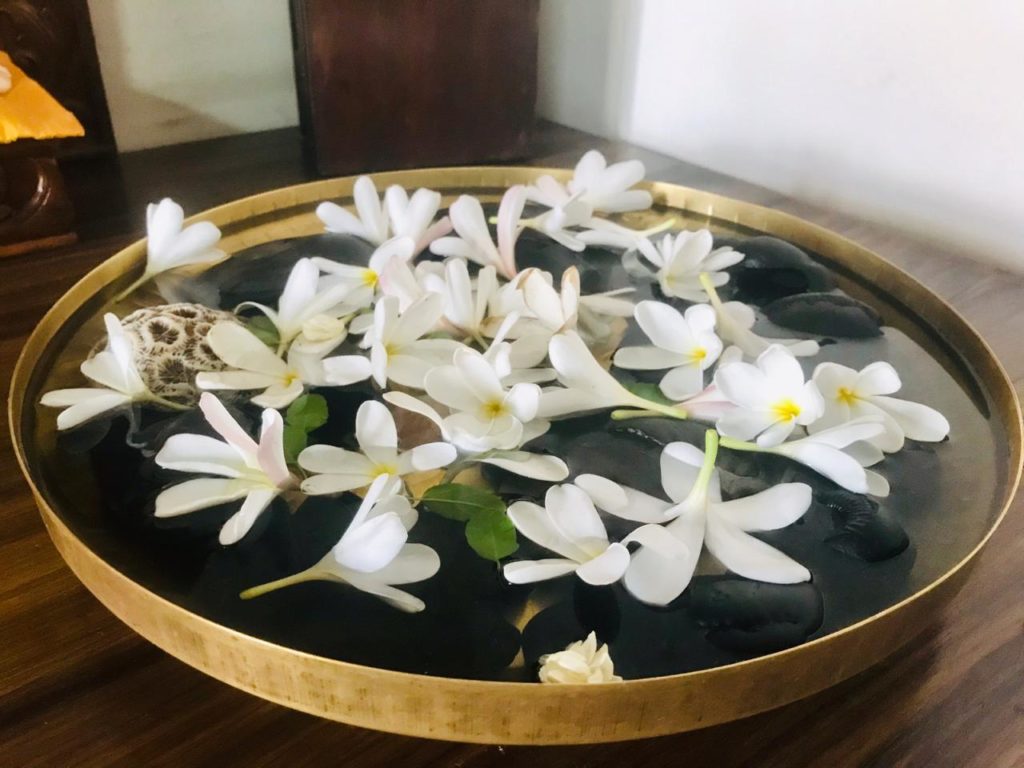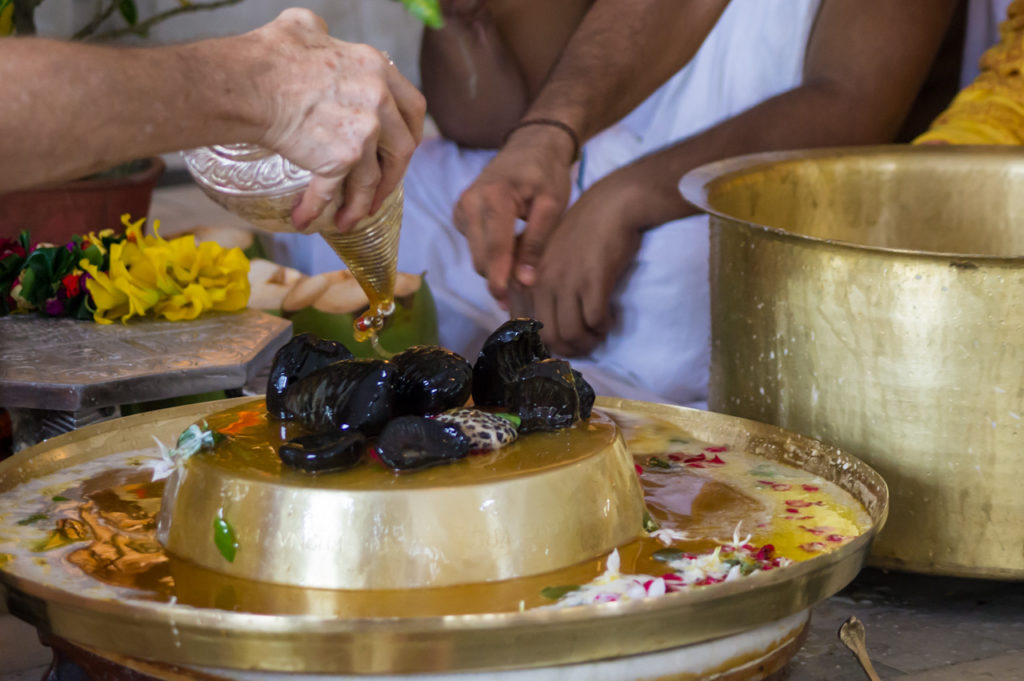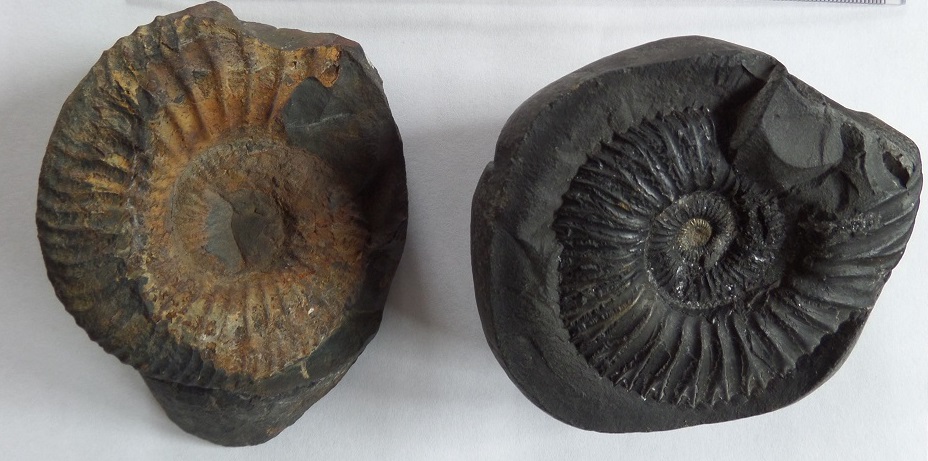This second part on the birth of Shaligrams is meant to briefly demonstrate the concrete links between the sacred contexts of Shaligram veneration and the actual practices devotees most commonly carry out. In other words, given the mythic histories of Shaligrams (previous post), how does one then actually experience the birth of a Shaligram and how do practitioners prepare them for ritual use in their homes and communities?
Puja is, first and foremost, the main method for venerating Shaligrams. Initial pujas are generally conducted when a Shaligram is born out of Kali Gandaki (often, right on the river bank using the water of the river to welcome them into their new families) and may be performed again and again over the course of the Shaligram’s lifetime. It is also common to include Shaligrams during pujas held for the births of children as well as at weddings and funerals or any other instance of a meaningful or profound change in an individual’s or family’s life. Pujas specific to Shaligrams are also most often performed during the festival celebrating Tulsi Vivah; the marriage of Tulsi and Shaligram (Vishnu).
The first puja for a Shaligram is almost always done as a welcome for them to their new home or temple following their birth and their long travels, just as puja is done for honored guests and great teachers. Subsequent pujas after that are much the same as any other kind of ritual care for a household’s deities and very commonly mirror the typical activities of daily life, such as mealtimes, bedtimes, bathing, and morning awakening. The final puja is then done to honor the passing of the dead, where a particularly important Shaligram may accompany the body of a deceased loved one into the cremation fire and carry their spirit into the presence of the Divine before being reborn back into the world (out of the river once again) in their place. Conversely, any Shaligram which is passed down/inherited and not sent to the funeral pyre will have a similar welcoming puja carried out, as it is once again a new member of a new family. And thus, Shaligrams continue to live out multiple karmic lives, returning again and again into the material world, so that they may guide souls along the path to moksha.
However, as far as religious stricture goes, it is important to note that there is no central Scriptural authority detailing the worship of Shaligrams in either Hinduism or Buddhism. Instead, most Shaligram practitioners take a variety of texts to be authoritative when it comes to Shaligram worship; be they a combination of the Vedas, Puranas, Shastras, or other commentaries. The scriptural rules which govern Shaligram veneration also do not establish a set of rigid boundaries delineating the correct performance of rituals for Shaligrams. Rather, they speak of Shaligrams in more general terms and leave many of the specifics up to long-standing oral traditions or other ritual descriptions. As such, real Shaligram practices function like the banks of a wide riverbed, much like the Kali Gandaki itself, within which streams of traditional and practical variation may appear, meander, and merge as they move through time and space. While the river may then slow to a trickle or come flooding out of the mountains, break up or reconverge, or even occasionally overflow its banks, it nevertheless carries onward in whatever way is necessary for the moment.
Lastly, there is no standardized doctrinal consensus among Shaligram practitioners as a whole, and specific individuals may perform or participate in Shaligram rituals reflective of any range of traditions, be they Buddhist, Hindu, animist, specific to one’s guru lineage, or related to a local deity or practice-style. Even secular, agnostic, and scientific atheists have been known to take part in Shaligram ritual veneration. But, for the most part, Shaligram devotees tend to acknowledge that Shaligram worship follows a few short, easily definable, steps.
Preparation:
As self-manifest deities, Shaligram require no rites of invocation, such as the prana pratistha. When they arrive home, they are greeted as living deities and are usually kept in a common section of the household, wherein they are able to view and participate in the normal activities of the family.
An active Shaligram within a household is usually cleaned with clear water to begin with, and then rubbed with oil to keep them smooth and unblemished. This oil can be from any number of sources but is usually made from sandalwood, flower extracts, or incense. Essential oils derived from fragrant plants are especially popular for this purpose.
Shaligrams then reside in whatever prepared puja mandir, platform, or shelf that has been set aside for them. Many devotees also provide them with small pillows or seats to rest on, crowns or clothing as befits other murti in the household, or any other small items they wish to offer or which may be specific to the Shaligram deity present (i.e., sweets for Krishna or coins for Lakshmi).
The two main offerings generally considered to be vital to Shaligram practice, however, are water and tulsi. Pilgrims to Mustang will often return with water taken directly from the Kali Gandaki for this purpose, but Ganga Jal also works well or any other purified water in the event that none other is available. Tulsi can be grown in the home (and often is) or purchased from Indian groceries if one’s climate is not suitable for growing.
Puja
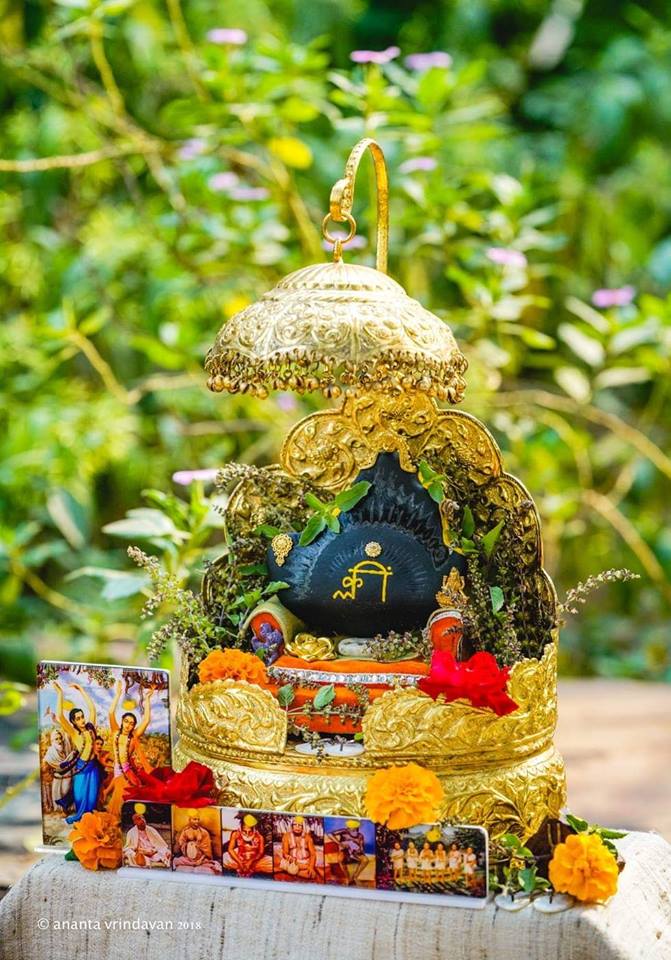
Shaligrams are typically worshipped without any prathisthana (installation ritual; as is done while installing man-made deity icons), since Vishnu is already present in the Shaligram of his free will as a revelation to the devotees. The ÅšÄlagrÄma-Kosha enumerates this by explaining that: “In the worship of Salagrama, no initiation is required; there is no special hymnology or specific procedure of worship, nor any need for a qualified priest or master of ceremonies. Worshipped anyhow, it will bestow the benefits; and there is no error of any kind.â€
Note: In South India, it is more common for Shaligrams to be put away in a box or puja mandir while not actively engaged in ritual, while in North India and Nepal, Shaligrams tend to remain in the open.
Sri Shaligram Shila Stotram (Prayer)
(Given by Krishna to Yudhishthira,
Bhagavad-Gita)
Yudhistiro Uvacha
King Yudhistira asked
“Shree Dev Dev devesa Devarchanamutamam
Tat sarbam srotaumichhami Bruhime Purushotamam / 1/
My dear Supreme Lordship Purushotam, I request you know the significance of the
Shaligram shila.
Shree Bhagavan Uvacha – The Lord Replied
“Gandakyam Chotare Tire Girirajshchya Dakshine
Das Yojan Vistirnam Mahachhetra Vasundhara //2//
“Saligramo Vabet Devo Devi Dwara Bati Vabet
Uvayo Sangamo Yatra Mutistratrana Sansaya //3//
“Saligramo Sila Yatra Yatra dwara Bati Sila
Uvayo Sangamo Yatra Mutistratrana Sansaya //4//
The mountains known as the Himalaya are situated on the bank of river Gandaki.
In the south of this Himalaya is the land where Shaligram shila appear. This is the place where Devi Dwarabati begins. This
place is called by those who know, Sri Muktikshetra.
“Ajanma Krita Papanam Prayaschitam Ya Ichati
Saligram Silawari Paphari Namastute //5//
“ Akal Mritu Haranam Sarvabyadhi Binasanam
Vishu Padodakam Pitwa Shirasha Dharyamyaham //6//
“Sankha Madhya Sthitam Toyyam Vramitam Keshavopari
Angalagnam Manukshanam Bramha Hatya Dikam Dayat //7//
Shaligram shilas found here are very
precious and significant. These shilas
are considered to be directly Lord Vishnu Himself and the person who worships
or even keeps in the house or bathes the Shaligram and drinks water or pour
those waters on their head, that man becomes free from all sin and it prevents
from untimely death. That person becomes free from all sin and all material
disease. The most feared sin of Bramahatya (killing of a Brahmin) is also
washed away simply by worshiping the Shaligram.
“Snano Dakam Piben Nityam Chakrankita Sirot Vabam
Partkshallya Sudham Tatoyam Bramha Hatya Byapohati //8//
“Agnistomasahasnani Vajapaya Satanicha
Samyak Phalama Bapnoti Visnornai Vedya Vakshina //9//
That person who does snan (bathing)
of Shaligram with chakra everyday get
gets rid of all sin like Bramahatya, and if he drinks such water daily gets the
equal boon of a thousand havan (fire
sacrifices) of Lord Vishnu.
“Naivadyayuktam Tulsim cha Misritam Vishesta Pada Jalen Vishnu
Yoshnati Nityam Purato Murari Prapnoti Yazya Uta Koti Pundyam //10//
The person, who worships Shaligram with Tulsi leaf daily, gets the boon of a million
Yajna also.
Khandita Sphutita Viina Vandi Dakdhya Tathi Va Cha
Saligram Sialyatra Tatra Dosho Na Vidyate//11//
Even if a Shaligram is damaged or broken, all shila are good to worship
Namantra Pujanam Naiva Natirtham Na cha Bhabanaa
Na stutir Na uppachars cha Saligram Silar cha ne //12//
Bramha Hatya Dikam Papam Manobak Karya Sambhamam
Shirgram Nachyati Tatsarvam Saligram Silrchana//13//
Without worship, without offering any sweets or without any pilgrims – only
chanting this Shaligram mantra is enough to wash away all sins and is the
fulfillment of all desire.
“Nanabarna Mayam Chiva Nana Bhogena Vestitam
Tathavarprasadena Laxmi Kantam Balamhayam //14//
“Narayanorbhabo Dev Chakramadya Cha Karmana
Tathavarprasadena Laxmi Kantam Balamhayam//15//
There are various kinds of size and shape of Shaligram in which Lord Vishnu is
situated representing all the different incarnations.
“Krishane Sila Taneyatra Susmam Cakram Cha Drisyate
Saovagyam Santatim Dhatye Sarva Sakshaym Dadhaticha//16//
Good Luck increases and one gets satisfaction from children, and in every way
in every aspect, all good enters one’s life by worshipping Shaligram black in
color with little chakras.
Vashu Devschya Chinhani Distwa Papai Pramuchyate
Sridhar Sukare Bame Harivbarnatu Disyate//17//
“Varaha Rupenam Devam Kurmangai Rapi Chinhitam
Gopadam Tatra Dissheta Varaham Vamanam Tatha //18//
A person who gets the chance to see the Vasudev shila, that person he became free from sins. Shreedhar, Sukar,
Vamanadev, Harivarna,Varaha, Kurma and lots of other type of Shaligram are
available also. Some Shaligram has marking of cow’s foot marks and some that of
Narshimha Avatara (half lion half man).
“Pitavarnam Tu Devanam Rakta Varnam Vayabhaham
Narashinho Vawet Devo Mokshadam Cha Prakrititam//19//
Sankha Chakra Gada Kurma Sankho Yatra Pradisyate
Sankha Varnaschya Devanaman Vame Devaschya Lakshanam//20//
“Damodarm Tatha Sthulam Madhya Chakram Pratisthitam
Purna Dwarena Sankrina Pita Rekha Cha Drischyate //21//
“Chhatrakare Vabet Rajam Vartule Cha Mahasreeya
Chipite Cha MahaDukham Sulagretu Ranam Dhrubam//22//
A yellowish Shaligram is as auspicious as the Lord Himself (Pitambara) but a reddish Shaligram is
considered to bring fearful situations and is dangerous to worship. The sacred
symbols of Shankha (conch), Chakra (disc), Gada (club), and Kurma (tortoise)
are printed on the Shaligram stones. Shaligram with a Shankha (conch) sign is
considered to be Vamanrup (Vamandev) of Lord Vishnu, whereas chakra in the middle is considered as
Damodar Shaligram. Shaligrams of different shapes; round, umbrella shape which
has white lines are also available; worshipping this kind of Shaligram gives
wealth and reputation in society. Flat shaped Shaligram creates sorrow in a
family and Shaligram with sharp front side creates war, fighting, and tension
in family.
“Lalate Shesha Vogastu Siropari Sukanchanam
Chakrakanchanavarnanam VamaDevaschya Lakshnam//23//
Vamaparbe Cha Bai Cakre Krishna Varnas tu Pingalam
Laxinarshimhadevanam Prithak Varnastu Drisyate//24//
Shaligrams which have a chakra around
the head or in the forehead but the rest of its parts are clean and smooth is
considered very auspicious and this type is to be considered as Vamandev shila. Yellowish or black in left side
with a chakra is considered as
Lakshmi-Narshimha shila.
Lamboste Cha Dalidram Syat Pingale Hani Revacha
Lagna Cakre Vabet Baydhir Bidare Maranamdrubam//25//
Worshipping a long shaped shila
creates poverty, and Shaligram having lagna
(rising) chakra create long term
chronic diseases, even death.
Padom Dakamcha Nirmalyam Mastake Dharayet Shada
Visnor Dristam Vakshitabyam Tulsi Jal Misritam//26//
Kalpa Koti Sahasrani Vaikunthe Basate Sada
Saligram Sila Vinur Hatya Koti Vinasanam//27//
Any person who offers a Tulasi leaf while worshipping the Shaligram gets
salvation and can stay at Vaikuntha (Heaven) for a million years.
Tasmat Sampujayet Dhyatwa Pujitam Chapi Sarvada
Saligram Silas Trotram Yah Pathecha Dijotam//28//
Sa Gakshet Parmam Sthanam Yatra Lokeshworo Hari
Sarva Pap Binir Muktwa Vishnu Lokam Sa Gashati//29//
Therefore always worship Shaligram, and chant Shaligram Stotra which is very
beneficial for mankind. We can get one a higher position on Vishnu Lok
(Vaikuntha) simply by doing so. All sins will also be destroyed and it is
guaranteed that one gets to Vishnulok simply from this process of worshiping
the Shaligram.
Dusovataro Devanam Prithak Varnastu Disyate
Ipsitam Labate Rajyam Vishnu Pooja Manukramat//30//
Kotyohi Vramhahatyanamgamyagamya Kotaya
Ta Sarva Nasamayamti Vishu Nai Vidya Vakshanat//31//
Vishno Pador Dakam Pitwa Koti Janmaghanasanam
Tasma Dasta Gunam Papam Ghumou Vindupatnat//32//
There are various types of descriptions available for Lord Vishnu’s ten primary
incarnations (Dasavatara) and also the Lord’s incarnation in Sri Shaligram’s worship,
the Prayer to the Shaligram and drinking the Lord’s bathing water wash away
sins of million lives and one gets great prosperity, wealth and reputation
through this, so everyone everywhere the Shaligram should be worshiped.
Iti Shree Vishotara Purane Shree Saligram Sila-stotram Sumpurnam!!..
Simple Puja
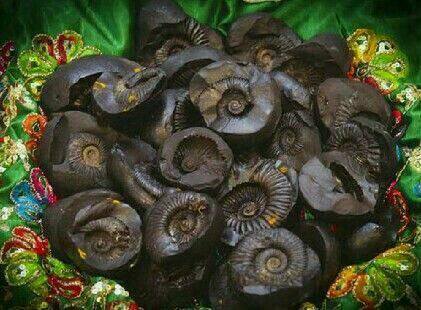
The most common and most basic form of Shaligram puja is the daily simple puja, which only requires that the devotee offer water, tulsi leaves (or flowers/fruit if none available), and a short prayer to the Shaligrams each day. In many cases, the simple puja is also favored among practitioners who travel or who are actively on pilgrimage since it is possible to bring one or two important Shaligrams along and to perform the puja as a kind of morning or evening prayer even under the most difficult circumstances. In many households today, simple puja is the standard, with more elaborate pujas performed on special occasions or at certain times of year.
As a corrective to modern concerns about the potential spiritual dangers of keeping Shaligrams, many gurus also now recommend the simple puja, elaborating that it is more important to give what an individual is capable of giving in order to keep Shaligrams in the home (and the tradition alive) than the alternative of never interacting with Shaligrams at all. In other words, as one of my teachers explained, “Shaligrams are not monsters. They are here for us, to help us. If simple puja is what you can offer. Offer that. The rest will come in time, when it is time.â€
Sri Vaishnava Tradition
If a Shaligram is to be formally worshipped in a temple context of the Sri Vaishnava tradition, all the details of worship must be carefully observed. Additionally, Shaligrams are also often strung together in the form of a garland using metallic casings made of silver and placed on the moolavar – the Dhruva bera (main temple deity) deity in Vaishnava temples. (108 in number representing the nine planets comprising the 27 stars and its four navamsa divisions – 27×4 = 108). Large Shaligrams (typically the larger than a man’s hand) are also routinely made into iconographic murti (Lord Krishna, Rama, Vishnu, etc.) and worshipped in temples and Vaishnava mutts.
Depending on the religious tradition in question, the ritual protocols for Shaligram worship vary considerably. However, the most commonly referenced method of Shaligram puja comes from the Sri Vaishnava tradition, where there is a more standardized procedure for the every-day worship of Shaligrams for temples, mutts, and home shrines. Generally, Shaligrams are almost always worshipped using tulsi leaves. The Yagna (Yaga) Samskaram also prescribes procedures for the Bhagavad Aradhana (Aradhana is a method of worship, a Sanskrit word meaning an act of glorifying God or a person) of Sriman Narayana -Vishnu or His manifest form of Shaligrams.
There are two forms of Aradhana: Bahya (External) and Manasika (Internal). Shaligram puja in a temple context usually begins when the attendant pujari or brahmacharya initiates the Samskaram through Sanskrit verses. The following protocol is translated into English by Anand K. Karalapakkam:
“After Achamanam (sipping and swallowing water two or three times during which the twenty-four names of Vishnu are repeated), wearing Oordhvapundram, prostrating to the Lord (Sriman Narayana), sit in a seat. After pranayamam (yogic control of the vital breath), perform japam (repetition of Lord’s name) with Dhyana slokas (divine hymns-Ashtakshara, etc). Later, worship the Lord Sriman Narayana residing in one’s heart (Manasika Aradhana). Then with water from the vessel placed left of Sriman Narayana (Shaligram), sprinkle water on flowers and other materials for worship and vessels for arghyam (offering of rice, etc.), padyam (offering of water for washing the feet), etc. From water in an arghya vessel, sprinkle water on flowers etc. (for worship) and also on yourself.”
“After welcoming the Lord, offer arghyam, padyam; Achamaniam and give Abisheka (ritualistic bath). Then offer cloth, Yajno Pavitha (sacred thread), sandal paste, flower, incense, and light, in that order. Offer Achamana, honey and again Achamana. Later offer food comprising of pudding, rice, vegetables, water, pan-betel etc. After prostration, restoring status quo is the procedure of worship of Vishnu.”
Thus, the sishya (disciple) learn to perform Bhagavad Aradhana (prayer of the divine) to Sriman Narayana’s archa-avatara as a Shaligram. Additionally, since the food a Sri Vaishnava eats should only consist of the remnants of food offered to Sriman Narayan, Saligrama Aradhana is considered to be especially important. Additionally, among Sri Vaishnavas, the Saligrama Aradhana is typically performed only by the male members of the upper three varnas (Brahaman, Kshatriya and Vaishya). In this tradition, women are prohibited from touching or performing Aradhana of a Shaligram, though this prohibition is not universally shared. However, even in these cases, women have an important role of assisting the performance of the ritual by making the necessary preparations for the worship including cooking the food for offerings to the deity. Women may also be responsible for arrangements in terms of preparing food, gathering and making flower garlands, or gathering and directing the participants as the ritual progresses. In general, however, most practitioners consider the participation of the entire family in Shaligram puja to be vital to the health and prosperity of the household.
Shaiva Traditions
Protocols for puja as set out by ritual specialists at Pashupatinath Mandir (from principally Shaiva and Smarta traditions) in Kathmandu, Nepal incorporate a slightly different sequence: In Puja Vidhi, Shaligram is worshipped in the same way as one worships Lord Vishnu. Normally tulsi is used and also a conch shell (Shankh) is kept near the Shaligram. Daily worship with purity of heart and body is required to get full benefits from Shaligram. (Ref.: Shrimaddevi Bhagwat and Pashupatinath Mandir).
To perform puja of the Shaligram which you have selected to install in your altar of worship, you will need the following ‘samagri’ or ingredients: Ganga Jal (water from the Ganges River), Panchgavya (a mixture of 5 auspicious articles that include: cow dung, cow’s urine, milk, ghee and curd), fresh tulsi leaves, kusha grass, pipal leaves, incense sticks, camphor, sandal paste, a lamp burner, and a conch shell. You may substitute any item that is not available with uncooked rice. Offerings made to the Shaligram can also be of milk, fruits, flowers, sweet dishes or a coconut.
Puja:
- Sit in a position in which you can face the East or North-East direction.
- Wash the Shaligram with Ganga Jal poured from the conch shell. Then wash it again with Panchgavya, and then wash it once more with Ganga Jal.
- Place some kusha grass in a stainless-steel glass filled with water to sprinkle over the Shaligram.
- Now, put the Shaligram on some pipal leaves placed on a plate. Light the camphor, incense sticks, and the lamp filled with ghee.
- Apply some sandal paste on the Shaligram and place some fresh tulsi leaves in front of the Shaligram.
- Light the lamp and move it in a circular, clockwise movement of the hand in front of the Shaligram.
- Chant the Shaligram mantra nine times. Other mantras may be substituted according to tradition.
- Offer milk, fruits or sweets to the Shaligram. Offer some money and then give that money to a poor person.
If you are worshiping more than one Shaligram, make sure they are in even numbers. This means that you should have either two, four or six Shaligrams. Place a tulsi mala (garland) around them or offer fresh tulsi leaves everywhere. It is important to remember that even the water that has touched the Shaligram becomes ‘amrit’ (holy water), while you are bathing it, it takes on the properties of the Shaligram. If you drink this water, it is said to bring relief from various physical ailments and poor health.
Because each specific Shaligram is read and interpreted in different ways, most Shaligram practitioners consider it essential that a Shaligram be properly examined and identified before they are taken for worship. Characteristics of particular focus are the shape and color of the Shaligram, the number and location of chakra marks, the type of lines or grooves that are present in the crevices and fissures, or any other distinctive feature which may indicate the deity’s ultimate identity. (To wit: reading and interpreting Shaligrams is the subject of my next planned book).
Smarta Traditions and Panchayatana Puja

In Smarta Traditions, the practice of Panchayatana Puja consists of the worship of five deities set in a five-point cross pattern. As a rule, these five deities are Shiva, Vishnu, Devi or Durga, Surya, and an Ishta Devata (a term meaning one’s favorite or tutelary deity) such as Ganesha, Skanda, or another god specific to the devotee’s practice. On rare occasions, an Ishta Devata may also be included as a sixth deity in the puja.
In Shaligram Panchayatana Puja, Shiva is often represented as a Linga stone from the Narmada river in India, the Devi/Shakti using a Srichakra (a Mandala-shaped quartz crystal or coin), and Ganesh, Vishnu, and Surya as Shaligrams. As per the tradition, any one of the represented deities can be placed in the center as the main or presiding deity. This deity is then the one who generally occupies a central role in the worship of the household and for whom the rest of the deities will be arranged around them (as is also mirrored in temple architecture from Odisha to Karnataka to Kashmir; and the temples containing fusion deities such as Harihara (half Shiva, half Vishnu)).
Theologically, the Smarta tradition emphasizes that all murti are icons of saguna Brahman, a means to realizing the abstract Ultimate Reality called nirguna Brahman. The five or six icons are then viewed by Smartas as multiple representations of the one saguna Brahman (meaning a personal God with material form), rather than as distinct beings in and of themselves. The ultimate goal in this practice is to transition past the use of icons, then follow a philosophical and meditative path to understanding the oneness of Atman (soul, self) and Brahman as infinite and immaterial.
Gaudiya Vaishnava and Hare Krishna Traditions
Finally, Sri Padmanabha Goswami’s “ŚÄlagrÄma-Å›ila†(1993) details the puja sequence more common in the Gaudiya Vaishnava and Hare Krishna traditions. He begins by explaining that the worship of Shaligram is not different than the worship of any other installed deity and in any case where reverence or respect to a deity would be performed, so must it be performed for Shaligram, with individual attention paid to each shila present. He then goes on to say that the worship of Shaligrams should be “conducted in accordance with PurusÍŽa-sukta.†(1993: 32). If a devotee wishes to adorn a Shaligram with ornaments, this is acceptable but that an offering of rice should never be made (in contrast with the Sri Vaishnava tradition mentioned previously).
Women are allowed to worship Shaligrams openly in these traditions but should refrain from doing so during menstruation and finally, that the specific mantras one should recite vary depending on the Scriptural texts used and should be whatever mantras are most well-known to the initiated Vaishnava.
The sequence for puja and the offering of five items; gandha, pus͎pa, dhūpa, dipa, and naivedya (tulsi is always required) or sixteen items then commences as so (additional descriptions for each piece of the sequence given in the text, pgs. 33-39):
- Wake the Lord
- After the Lord has risen, chant idam pusÍŽpanjali samarpayami and offer flowers.
- Asana (a seated posture) – while offering asana, chant idam asanam samarpayami
- Svagata (welcome) – while offering svagata, chant susvagatam, susvagatam
- Padya (poem, verse) – while offering padya, chant idam padyam samarpayami
- Arghya (libation) – while offering arghya, chant idam arghyam samarpayami
- Acamana (sipping water) – while offering acamana, chant idam acamaniyam samarpayami
- Madhuparka (honey and milk) – while offering madhuparka, chant idam madhuparka samarpayami
- Punaracamana (sipping water again) – while offering punaracamana, chant idam punaracamaniyam samarpayami
- Snana (bathing) – while offering snana, chant idam snaniyam samarpayami
- Vastra (clothing, or a cloth) – while offering vastra, chant idam vastram samarpayami
- Upavita (sacred thread) – while offering upavita, chant idam upavitam samarpayami
- Abhushana (ornaments, embellishments) – while offering abhushana, chant idam abhushanam samarpayami
- Gandha (fragrance) – while offering gandha, chant idam gandham samarpayami
- Tulasi (tulsi leaves) – while offering tulasi, chant idam tulasim samarpayami
- Pus͎pa (flowers) – while offering pus͎pa, chant idam pus͎pam samarpayami
- Dhupa (incense) – while offering dhupa, chant idam dhupam samarpayami
- Dipa (lamp) – while offering dipa, chant idam dipam samarpayami
- Naivedya (an offering to God; i.e., a promise, a willingness, etc.) – while offering naivedya, chant idam naivedyam samarpayami
Incidentally, he also mentions that the mantra: om yajneshvaraya yajnasabhavaya yajnapataye govindaya namo namah from Hari-bhakti-vilasa (15/530) also suffices for all steps from padya to dipa.
